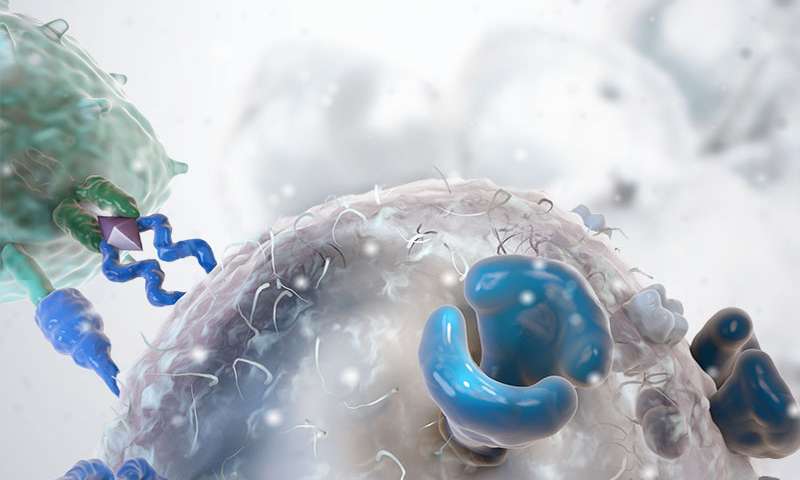Abstract
Adoptive cell therapy (ACT) has proven to be highly effective in treating blood cancers, but traditional approaches to ACT are poorly effective in treating solid tumors observed clinically. Novel delivery methods for therapeutic cells have shown promise for treatment of solid tumors when compared with standard intravenous administration methods, but the few reported approaches leverage biomaterials that are complex to manufacture and have primarily demonstrated applicability following tumor resection or in immune-privileged tissues. Here, we engineer simple-to-implement injectable hydrogels for the controlled co-delivery of CAR-T cells and stimulatory cytokines that improve treatment of solid tumors. The unique architecture of this material simultaneously inhibits passive diffusion of entrapped cytokines and permits active motility of entrapped cells to enable long-term retention, viability, and activation of CAR-T cells. The generation of a transient inflammatory niche following administration affords sustained exposure of CAR-T cells, induces a tumor-reactive CAR-T phenotype, and improves efficacy of treatment.
INTRODUCTION
Adoptive cell therapy (ACT) is a promising new strategy to treat cancer that has been shown to be highly efficacious in the treatment of blood cancers. In the ACT process, immune cells are collected from a patient, isolated and engineered with receptors to recognize and eradicate cancerous cells, expanded to therapeutically relevant cell numbers, and then infused back into the patient for treatment. Chimeric antigen receptor (CAR)–T cells are engineered to target an antigen that is overexpressed on cancer cells. This strategy has been widely effective in treating various B cell malignancies, and several therapies have recently been approved by the U.S. Food and Drug Administration (1). Unfortunately, while numerous concerted efforts have sought to translate the successes of ACT into treatments for the multifarious solid tumors observed clinically (2), the traditional approaches to ACT have seen limited success in treating these solid tumors (1).Currently, CAR-T cells are primarily delivered through intravenous infusion, which is effective in treating blood cancers because the T cells are able to readily find and eradicate cancerous cells. Unfortunately, large numbers of CAR-T cells are typically required for current treatment strategies to be successful, which requires costly, complex, and labor-intensive ex vivo expansion of the therapeutic cells that can inhibit their effector potential when transferred for treatment (3, 4). Moreover, CAR-T cells administered in the typical way exhibit poor activity against solid tumors, as it is challenging for the cells to find, infiltrate, and expand within the typically immunosuppressive tumor microenvironment following systemic administration (1). In contrast, novel cell delivery methods, particularly those exploiting biomaterial scaffolds containing stimulatory molecules, can improve upon systemic delivery for treatment of solid tumors and elicit increased expansion of T cells at the injection site, improved tumor infiltration, and enhanced efficacy (5–9). Unfortunately, the biomaterial scaffolds developed for ACT to date often require complex manufacturing protocols that are not easily tuned to different solid tumor applications (10). Furthermore, these materials often require invasive surgical implantation procedures to reach tumor sites, hindering translation and limiting the use of these approaches to postresection applications, or have demonstrated applicability in immune-privileged tissues (6, 7, 9, 11).Effective therapy requires that CAR-T cells are highly activated at the tumor site (12, 13), yet the high cytokine concentrations required for CAR-T activation lead to severe toxicities if delivered systemically, which typically precludes their use therapeutically. In current clinical approaches, T cells are expanded in high concentrations of cytokines and then isolated before administration into patients to avoid the toxicities associated with the cytokines. While locoregional delivery of cytokines can limit systemic cytokine exposure and reduce systemic toxicities (14), their low molecular weight and rapid elimination often require that the cytokines themselves be modified using protein engineering strategies to ensure sufficiently long-term local retention (15). The biomaterial scaffolds leveraged to date for locoregional delivery of CAR-T cells and cytokines have required the cytokines to be specially formulated either in microspheres or insoluble forms within the biomaterial to prevent rapid release (7, 9).On the basis of the promising results from previous studies of locoregional delivery of both CAR-T cells and cytokines (7–9), we hypothesized that next-generation biomaterials affording enhanced control over the co-delivery of CAR-T cells and immunostimulatory molecules will have the potential to realize effective ACT treatment strategies for solid tumors. For this approach, we drew inspiration from recent reports in the field of tissue engineering, which suggest that locoregional delivery of stem cells in physically cross-linked hydrogel scaffolds both improves cell viability during injection and enhances cell retention at the targeted injection site to facilitate local expansion of transplanted cells (10, 16, 17). In this work, we engineered a self-assembled and injectable biomaterials platform for CAR-T cell delivery based on Polymer-Nanoparticle (PNP) hydrogels (Fig. 1) (17–22). These hydrogels leverage highly scalable chemistries (23) and can be formulated under mild conditions that facilitate facile encapsulation of CAR-T cells and cytokines without the need for modification of the cargo. We show that the unique properties of these hydrogels enable facile administration via direct injection and the creation of a transient inflammatory niche in vivo that enhances CAR-T cell expansion and activation, profoundly improving efficacy in treating solid tumors in mice (Fig. 1A). We also demonstrate that similar efficacy is observed whether the treatment is administered proximal or distal to tumors, suggesting that this approach may be more broadly applicable for the treatment of metastases or tumors that are not easily accessible via direct injection or catheter delivery….







